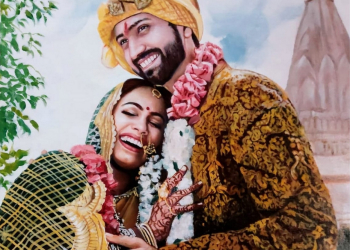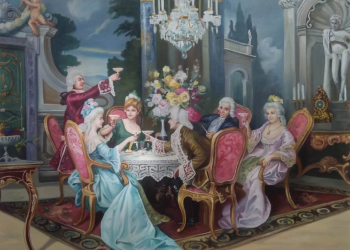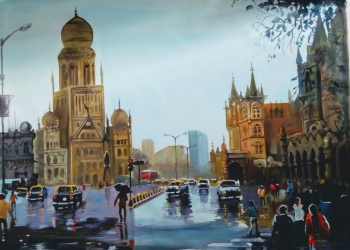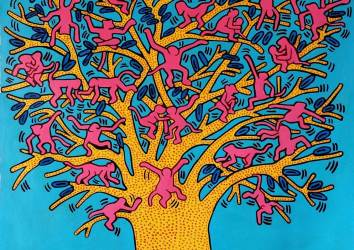When MF Husain’s Gram Yatra sold for a record-breaking ₹118 crore, it reignited the age-old debate - how do you truly value art? Let’s decode the economics behind the masterpiece.
In the last few weeks, there has been considerable excitement in the Indian art world, among gallerists, art collectors, and art lovers. The cause of the excitement?
The British state media BBC reported that a rediscovered work of Indian artist MF Husain was auctioned for record sums. On March 19th 2025, Husain's monumental 14-foot-wide mural, Untitled (Gram Yatra), fetched a record-breaking $13.8 million (£10.6 million) at Christie's New York, surpassing the previous high for an Indian artist, the iconic Amrita Sher-Gil's The Story Teller, which sold for $7.4 million (Rs 61.8 crore) in 2023.

Gram Yatra by MF Hussain - The most expensive painting sold for 118 cr
Christie's New York auction saw MF Husain's Untitled (Gram Yatra - The Village Pilgrimage) achieve a record-breaking sale price of Rs 118 crore ($13.8 million).
 The previous most expensive painting, The Storyteller, by Amrita Sher-Gil, 1937 (Image Credits: Wikipedia Commons)
The previous most expensive painting, The Storyteller, by Amrita Sher-Gil, 1937 (Image Credits: Wikipedia Commons)
Title: The Story Teller
Creator: Amrita Sher-Gil
Date: 1937
Type: Oil Painting on Canvas
Physical Dimension: 23 inches × 31 inches (59 cm × 79 cm)
Location: Private Collection
A post on LinkedIn by Abishek Murarka caught my attention, debating the merits of the price. Investors were incredulous that a painting sold for 118 crores. How could this price be justified? How do you value art? After all, no cash flows can be used to perform a DCF (discounted cash flow — a method of valuing businesses and stocks) for valuation. No less than Aswath Damodaran, the Professor of Finance at the Stern School of Business at New York University and regarded as the world's foremost expert on valuations, commented on the post. This post aims to shed some light on the rarefied world of art valuations and the factors that drive them.
Order Your Commissioned Painting from Photo today!
How is the value of artwork determined?
Art cannot be valued like traditional business investments or equity investments, as there are no cash flows to conduct a DCF analysis.
In his book, Narrative and Numbers, Professor Damodaran correctly assesses that business valuations are driven by two factors, numbers (cash flows) and the narrative of the company (the story).
Unlike businesses and stocks, artworks lack liquidity and objective valuation metrics. Author Don Thompson, an economist and Professor of Marketing and Strategy at the Schulich School of Business at York University, observed in his book The $12 Million Stuffed Shark that the art market is driven by taste, status, and speculation rather than fundamentals. In other words, the market is narrative-heavy. (Fun fact: Damien Hirst’s installation art, The Physical Impossibility of Death in the Mind of Someone Living, is an actual stuffed shark in formaldehyde that sold for USD 12 million*.)
 The Physical Impossibility Of Death In The Mind Of Someone Living by Damien Hirst 1991 (Image Credits: Wikipedia Commons)
The Physical Impossibility Of Death In The Mind Of Someone Living by Damien Hirst 1991 (Image Credits: Wikipedia Commons)
Title: The Physical Impossibility Of Death In The Mind Of Someone Living
Creator: Damien Hirst
Date: 1991
Type: Conceptual Installation
Physical Dimension: 84 in × 204 in × 84 in (213 cm × 518 cm × 213 cm)
Location: Private Collection
The art market operates like a luxury goods industry, where branding and perception matter more than intrinsic value. The history of ownership (provenance), cultural significance, rarity, demand, and supply heavily influence an artwork’s price.
Without cash flows, the value of an artwork is driven by its narrative, which includes the cultural significance, authenticity, rarity, provenance, and demand and supply.
For example, consider the valuation of Leonardo's Mona Lisa.
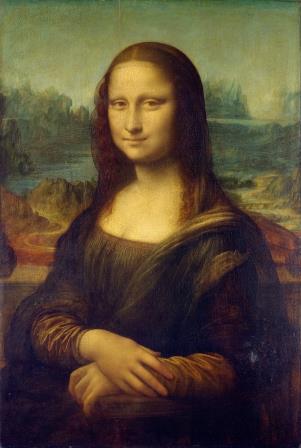 Monalisa by Leonardo da Vinci (Image credits: Wikipedia Commons)
Monalisa by Leonardo da Vinci (Image credits: Wikipedia Commons)
Title: Mona lisa
Creator: Leonardo da Vinci
Date: 1503–1506, perhaps continuing until 1517
Medium: Oil portrait painting on poplar panel
Physical Dimension: 30 inches x 21 inches (77 cm x 53 cm)
Location: Louvre Museum, Paris, France
In 1962, when Monalisa went on a special exhibition tour of the USA at the request of the US First Lady, Jacqueline Kennedy. The insurers valued the painting at USD 100 million for the move. From the Louvre in Paris, to Washington, DC, and then to New York City in the USA. This was the highest known valuation for a painting at that time. The insurance was not taken out, and instead, money was spent on the security of the painting. The current inflation-adjusted value of the painting will be USD 1 billion. But in reality, the Mona Lisa is priceless, as the Louvre museum will never sell it.
The value of Mona Lisa is derived from four factors. Authenticity, Rarity, Provenance, and Demand and Supply.
Much of the value of Mona Lisa is derived from her popularity. But she was not always famous. She became famous only after the painting was stolen in 1911 from the Louvre museum, which led to a great media furore, that ultimately made Mona Lisa, the cultural icon she has now become.
In our previous post, you can read the fun story of the rise of Mona Lisa in the art world that we shared. Why is the Mona Lisa so famous?
Coming back to MF Husain’s Gram Yatra value. Let's try to deconstruct the pricing based on the main factors—
Check our Handmade Art Reproductions & Landscape Paintings
Factors in determining art valuation
Authenticity of the Artwork
Is MF Husain's painting Gram Yatra worth 13.8 million or 118 crores? The answer is, no one knows. Just like in DCF, you can make a series of assumptions to come out with a range of values for companies, so is the case for valuing art. But unlike company valuations, which are numbers-heavy, art is narrative-heavy. So can the price be justified? Maybe yes, maybe no. Just like narratives can be used to justify a company's valuation, the same can be used to justify the price of Husain’s work. Husain is one of those rare artists from India who has a brand pull. People may or may not appreciate his work, but the common man on the street knows his name. And that has value. Husain was a master storyteller. His works, like his painting of Mother Teresa, his horse paintings, and his painting of Bharat Mata, made news and stirred up controversy. Or his movie Gajagamini with his muse Madhuri Dixit stirred up the media and created socio-cultural impact.
Rarity of the Artwork
Husain is no longer with us. That means there will be no more new Husain paintings ever. The implication is that all his earlier works are now more valuable than ever before. And with the record value of Gram Yatra, all his previous works, his back catalog if you will, have been repriced to reflect this new valuation. But we must keep in mind that while rarity alone is not sufficient to drive prices, it is certainly an enabling condition.
Provenance Artwork or Painting
I am sure the artwork would have been thoroughly appraised and its history traced back by art experts who would have certified the work as 100% authentic. Only then will prospective clients be willing to splurge 100s of crores on it. So it can be safely assumed that the work is authentic.
Demand and Supply
Basic law of economics tells us that when supply is limited and demand is high, the price has only one way to go. UP. Buying a Husain now or in the future is making a statement. After all, how many can boast of buying a 100-crore painting? A handful, maybe. It automatically adds prestige, awe, open doors and networks, and bragging rights to the owner/art collector. But that is not all.
India is modernizing & urbanizing rapidly. Every new city that develops will have art museums, galleries, and cultural centers that add to the demand for showstopper artworks. Directors and CEO’s of these institutions would want to have as many showstopper artworks in their museums and galleries that will aid in pulling visitors, patrons, and media coverage, which builds up these institutions. And the supply of showstopper artworks or artists is limited. Husain’s work, along with a handful of artists in India, certainly qualifies as showstoppers.
Risk factors in Art investing
So looks like a decent investment, doesn’t it? But wait, what about the risk factors?
Investing in art is fraught with risks. Especially since they have no cash flows. The valuation is dependent on factors of rarity, provenance, taste, cultural significance, and demand and supply. If any of these implicit assumptions are hit, the valuations too will take a hit. Let's go through them
Rarity & Cultural Significance of the Artwork
In art, "Cultural Significance" is akin to terminal value in business valuations and just as nebulous. A significant value of the artworks of Husain or any other artist, for that matter, is driven by their popularity, cultural significance, tastes, and how contemporary art audiences relate to them. We don't know if an artist's popularity will endure over the next 50 years, or 100 years
Husain was a prolific artist. According to a Guardian report, Husain made over 40,000 paintings. So they are not exactly rare. Just for comparison, fewer than 20 works by Leonardo have survived.
Thus, “cultural significance” carries a significant risk. At the turn of the last century, Raja Ravi Varma's works were immensely popular. But by the end of the artist's life, his popularity and interest in his artworks had waned considerably.
In his book, Art and Nationalism in Colonial India 1850-1922, art historian Partha Mitter notes, "In 1906, the last year of his life, Ravi Varma's reputation as a national figure seemed unassailable. And yet, almost overnight, his works fell from grace."
Only now, in the last few decades, interest in Raja Ravi Varma’s artwork has again revived, and so has the value of his works.
To give a more recent example, digital art sold as NFTs (Non-fungible tokens) sold for record sums. For example, in 2021, Sotheby’s sold Bored Ape #8817 for a record-breaking $3.4 million. On Feb. 12, 2024, Coingraphs notes golden Bored Ape #1726 with similar attributes sold for just 275 ETH or $665,000. According to a study by DappGambl, a crypto gaming site, Of the 73,257 NFT collections, an eye-watering 69,795 of them have a market cap of 0 Ether (ETH). This statistic effectively means that 95% of people holding NFT collections are currently holding onto worthless investments."
Clearly, public tastes and adulation are fickle, prone to the vicissitudes of man. An ever-clear and present danger for art investors.
Demand and Supply for artists' works
Demand and supply for artists' works directly depend on the continued “cultural significance” of the artist and their works. Any impairment to their brand name, for whatever reason, might seriously impact the value of their works.
Moreover, a small fraction of the 40,000 Husain paintings are probably available in the market right now. But over time, maybe more and more of Husain's artworks will become available in the market.
It is no surprise that the world's most expensive painting, Salvator Mundi by Leonardo da Vinci, sold for $450.3 million (INR 3848 crores) in 2017, driven by rarity (one of the few Da Vinci works) and historical significance. A question for future collectors and investors is what happens to the valuations when a fraction of Husain's works of 40,000 become available in the market.
Provenance of the artwork
Any artwork by Husain, or for that matter any other artist, will hold little or no value if the provenance is unclear. Both collectors and investors will be hesitant to loosen their purse strings for artworks with questionable provenance.
Knowing these dynamics, auction houses hook onto the power of exclusivity and prestige, hosting glamorous events and exclusive previews to attract the “right” clientele for their auctions.
Role of Auction Houses (Sotheby's auction, Christie's auction)
The very mechanics of auctions held by auction houses like Sotheby’s or Christie’s create an adrenaline-fueled competitive bidding environment, where reason often takes leave, bidders get caught up in the excitement, often bidding for art pieces, far beyond what may be the estimated value of the art. Most bidders don’t want to back down, as you lose “face”, appear weak, or lose to a rival. This explains to some degree the extraordinary valuations some artworks can garner.
In the end, Art, like beauty, exists in the eye of the beholder—and in the pockets of those willing to pay for it. Husain’s ₹118 crore sale is not just about paint on canvas, but about the narrative spun around it. Justified? Maybe. But in a world where a banana duct-taped to a wall sells for $120,000, perhaps ₹118 crore is a steal for owning a legend.
Is this the end? Not quite. The Indian art world is just getting started. We have some fantastic talent in this country that deserves great recognition. Future art prices by Indian artists will break even more records. But for now, here’s an updated infographic of the 5 most expensive Indian artists and their paintings.
 Infographic: 5 Most Expensive Paintings by Indian Artist (Image credits: Paintphotographs.com)
Infographic: 5 Most Expensive Paintings by Indian Artist (Image credits: Paintphotographs.com)
About Us:
Paintphotographs.com is India's leading custom art platform. We turn your favorite photos, pics, and images into luxurious handmade portrait paintings. Our work includes handmade portraits, custom oil reproductions, charcoal drawings, and sketches. As a team of accomplished artists, we use museum-quality canvas, the best international brands of colors such as Winsor & Newton and Daler Rowney. We work with various mediums, including oil, acrylic, mixed media, graphite, and charcoal.
To order a custom handmade oil portrait painting, you can visit our order now page. You can order custom Wedding Paintings, Couple Paintings, Memorial Paintings, Family Paintings, Baby portraits and Children Paintings, Photo to paintings, and Pet Portrait Paintings from Photo.
You can visit our pricing page to know the prices of our portrait paintings. To connect with us ping us on our chat messenger on the website, ping us on WhatsApp, call us at 918291070650, or drop us an email at support@paintphotographs.com
You can visit our gallery pages to see our work. We make photo to paintings, couple paintings, memorial paintings, Kids and Baby Portrait paintings, God & Religious Paintings, Old Photo to Paintings, Wedding couple Paintings & Marriage Portraits, Family Paintings, Pet Portrait Paintings, Radha Krishna Paintings, Oil Portraits of Gurus, Saints & Holy Men, Charcoal and Pencil Sketches, Custom Landscape & Cityscape paintings, Contemporary Art Reproduction & Replica Paintings, Old Master Reproduction & Replica Art, Monochrome and Black & White portrait paintings, Historical Portraits and Shivaji Maharaj Paintings, Celebrity & Political Leaders Portraits. We can also merge separate photos to create a single seamless painting called Composite portraits to add deceased loved ones to make a family oil portrait as though they were present.
Our custom handmade portraits make beautiful Anniversary Gifts, Engagement Gifts, Birthday Gifts, Retirement Gifts, Housewarming Gifts, Mother's Day gifts, and luxurious gifts for many important occasions.
Paintphotographs.com provides bespoke services for art patrons, interior designers, and architects. It helps you create the perfect pieces for residential and commercial projects and serves as a platform for artists to showcase their work.
If you are an art aficionado interested in writing a guest post on art, connect with us.
For sources referenced in the article, please refer to the Notes and References section.
Like this story? Then you will love our podcasts on Spotify. Listen to our deep dives and fascinating stories from the art world. Join our nearly 20,000-strong community on Facebook, WhatsApp, and X.
Want to see our art? Join our community of 500,000+ subscribers on the Paintphotographs YouTube channel, Instagram, and Pinterest for some amazing art pics & art videos!
This piece is contributed by Sougata Ghosh. From art to economics, history to tech, markets to investing and entrepreneurship, he is a jack of all trades—master of none (his words, not ours). You can find him on LinkedIn.
Recommended Pieces
Farewell gifts for Seniors, Colleagues and Friends: Handmade Portraits | Paintphotographs
15 Best Canvas Painting Wall Art Ideas for the Living Room! | Paintphotographs
Making of a Family Painting from a 100 Year Old Photo: Reviving the Past | Paintphotographs
Bold, Beautiful & Bisexual: Amrita Sher-Gil – India’s LGBTQ Art Icon | Paintphotographs
The paintings in John Wick Chapter 4 | Paintphotographs
Sunayani Devi: The Naive Primitivist Who Pioneered Modern Indian Art | Paintphotographs
A Closer Look at the Stunning Paintings in Coca-Cola's Latest Ad “Masterpiece” | Paintphotographs
Photorealism: The Art of making a painting from a photo. | Paintphotographs
The life and paintings of artist and painter KCS Paniker | Paintphotographs
India's Greatest Portrait Painters: Lives of 13 Oil Portrait Painting Masters | Paintphotographs
Ultimate 20 Best Oil Portrait Paintings of John Singer Sargent (Ranked) | Paintphotographs
The Artistic Genius of Abanindranath Tagore: Rediscovering His Early Works | Paintphotographs
Hemendranth Majumdar and his Wet Sari paintings: Last Romantic Naturalist Artist | Paintphotographs
25 Luxury Wedding Gifts For Couples In India | Paintphotographs
Notes and reference section
*The parties never disclosed the actual selling price of the conceptual art piece Death in the Mind of Someone Living. USD 12 million was the most widely cited figure in the media at that time, according to Don Thompson in his book The $12 Million Stuffed Shark: The Curious Economics of Contemporary Art.
Indian mural that spent decades on Norwegian hospital wall sells for record $13.8m
$12 Million Stuffed Shark Reviews & Ratings - Amazon.in
Highest insurance valuation for a painting | Guinness World Records
MF Husain: the barefoot 'Picasso' of Indian art | Culture | The Guardian
Some NFTs sold for millions — What are they worth today?
95% of NFTs are Dead - Trends, Predictions & Statistics 2025
How many Leonardo da Vinci paintings are there? | Britannica
List of most expensive paintings - Wikipedia
Banana duct-taped to a wall sells for $120K at Art Basel Miami


